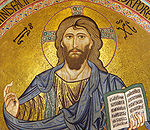- Christianity in the Philippines
-
Christianity by Country
North AmericaSouth AmericaOceaniaThe Philippines is one of two predominantly Roman Catholic nations in Asia, the other being East Timor. About 93% of the population is Christian, about 5% are Muslim and about 2% are other or none.
Contents
History
In the 1521, the Portuguese explorer Ferdinand Magellan arrived in the Philippines while sailing for Spain in search of a route to the East Indies. Spanish and Portuguese explorers landed on the island of Limasawa in the Philippines.
At this time period, almost nothing was known to the west of the Philippines and so our sources of information about pre-Hispanic societies in the country date from the early period of Spanish contact. Most Philippine communities, with the exception of the Muslim sultanates in the Sulu Archipelago and Mindanao, were fairly small without a great deal of centralized authority.
The absence of centralized power meant that a minority of Spanish explorers were able to convert a large number of indigenous tribes living in politically autonomous units more easily than they could have, say, converted people living in large, organized, complex kingdoms such as those Hinduized or (later) Theravada Buddhist-influenced kingdoms in mainland Southeast Asia, the Malay Peninsula and the Indonesian Archipelago. The Spanish were unsuccessful in converting Muslim Sultanates to Christianity, and in fact warred with Muslim Filipinos throughout their 300 year colonial rule from 1521-1898. Nor did they successfully conquer certain highland areas, such the Luzon highlands, where a diverse array of ethno-linguistic groups used their remote, difficult mountainous terrain to successfully avoid colonization.
Magellan's arrival in Mazzua represents the first attempt by Spain to convert the Indigenous tribes of the Philippines to Roman Catholicism. The story goes that Magellan met with Rajah Humabon of the island of Cebu, who had an ill grandson. Magellan (or one of his men) was able to cure or help this young boy, and in gratitude Chief Humabon allowed 800 of his followers to be 'baptized' Christian in a mass baptism. Later, Datu Lapu Lapu the chieftain of Mactan Island killed Magellan and defeated the Spaniards. This resistance to Western intrusion makes this story an important part of the nationalist history of the Philippines. Many historians have claimed that the Philippines peacefully 'accepted' Spanish rule; the reality is that many insurgencies and rebellions continued on small scales in different places through the Hispanic colonial period.
After Magellan, the Spanish explorer Miguel López de Legazpi arrived in the Philippines and he conquered a Muslim settlement in Manila in 1570. Islam had been present in the southern Philippines since some time between the 10th and 12th century. It slowly spread north throughout the archipelago, particularly in coastal areas.[1]
See also
- Roman Catholicism in the Philippines
- History of Eastern Christianity in the Philippines
- Iglesia ni Cristo
- Philippine Independent Church
- Philippine Orthodox Church
- Protestants in the Philippines
References
Further reading
- Fenella Cannell, 1999, Power and Intimacy in the Christian Philippines. Cambridge: Cambridge University Press.
- David J. Steinberg, 1982, The Philippines: A Singular and a Plural Place. Boulder, CO: Westview Press.
Religion in the Philippines Abrahamic ChristianityBread of Life Ministries International · Cathedral of Praise · Christ's Commission Fellowship · Christian and Missionary Alliance · Day by Day Christian Ministries · Greenhills Christian Fellowship · New Life Christian Center · True Jesus Church · Victory Christian FellowshipAssemblies of God · Cathedral of Praise · Foursquare Gospels · Jesus Is Lord Church · Jesus Miracle Crusade · Kingdom of Jesus Christ · Pentecostal Missionary Church of Christ (4th Watch)Anglican Communion (Episcopal) · Baptist · Baptist Bible Fellowship International · Christ Centered Church · Iglesia Evangelica Metodista · Iglesia Unida · Lutheran · Presbyterian · Salvation Army · United Church of Christ · United MethodistEthnic/Folk Indian Others Christianity in Asia Sovereign
states- Afghanistan
- Armenia
- Azerbaijan
- Bahrain
- Bangladesh
- Bhutan
- Brunei
- Burma (Myanmar)
- Cambodia
- People's Republic of China
- Cyprus
- East Timor (Timor-Leste)
- Egypt
- Georgia
- India
- Indonesia
- Iran
- Iraq
- Israel
- Japan
- Jordan
- Kazakhstan
- North Korea
- South Korea
- Kuwait
- Kyrgyzstan
- Laos
- Lebanon
- Malaysia
- Maldives
- Mongolia
- Nepal
- Oman
- Pakistan
- Philippines
- Qatar
- Russia
- Saudi Arabia
- Singapore
- Sri Lanka
- Syria
- Tajikistan
- Thailand
- Turkey
- Turkmenistan
- United Arab Emirates
- Uzbekistan
- Vietnam
- Yemen
States with limited
recognition- Abkhazia
- Nagorno-Karabakh
- Northern Cyprus
- Palestine
- Republic of China (Taiwan)
- South Ossetia
Dependencies and
other territories- Christmas Island
- Cocos (Keeling) Islands
- Hong Kong
- Macau
Wikimedia Foundation. 2010.

